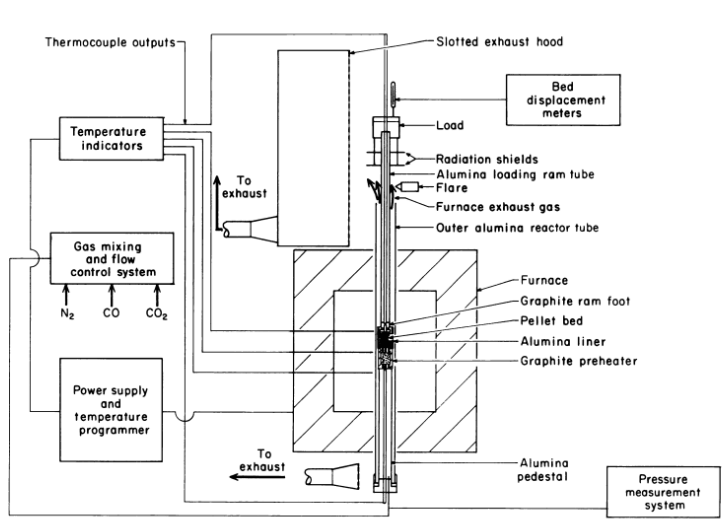Improving Acid & Fluxed Pellet Metallurgical Properties
Production pellets from each Minnesota taconite operation were obtained for baseline metallurgical testing. Concentrate from several of the operations was obtained for more intensive studies. Bench scale pellets were produced using a balling tire and a mini-pot pelletizing furnace. The mini-pot has a .1 ft² area and fires approximately 2000 gms of green balls in […]
Carbon Strip Circuit Control Scale
Carbon strip circuits present a particularly challenging scale inhibition problem. Many of the factors that tend to promote scaling are present in these systems. For example, carbon strip circuits are run at high temperatures, high pH levels, and require long batch cycle times. Tortuous paths are encountered by the strip solution circulating through heat exchangers, […]
Iron Oxide Pellets

Develop methods of enhancing and measuring the high-temperature softening and melting properties of iron oxide pellets reduced under simulated blast furnace smelting conditions. Add dolomite and limestone flux and a low-cost organic binder, such as starch, carboxyl methylcellose (CMC), or waste papermill sludge, to the iron oxide concentrate to produce hematite (ferric oxide) pellets with […]
Reduce Copper Loading on Carbon during Gold Adsorption
Copper mineralogy contributes a significant load of metals to the carbon adsorption circuit. Copper as [Cu(CN)2-] impedes adsorption of [Au(CN)2-]. If in high relative concentration, [Cu(CN)2-] loads faster than [Au(CN)2 ]; occluding adsorption space otherwise occupied by [Au(CN)2], Copper as [Cu(CN)3²-] and/or [Cu(CN)4³-] is weakly adsorbed onto activated carbon. Conversion of copper to the higher coordination […]
Recover Scrap Chromium by Pyrometallurgy Process
The experimental program described in this report demonstrated key process steps for the recovery of chromium as ferrochromium in a batch process. The process involves oxidation of chromium into a slag phase, subsequent separation of the slag phase from the remaining metal, followed by reduction of chromium from the slag phase to produce ferrochromium. Although […]
Ni-Cd Nickel Cadmium Recovery Method in Scrap Batteries
As part of a continuing effort to maximize metal recovery from domestic secondary resources, the Bureau of Mines investigated a process for recovering the metallic portion of scrap alkaline batteries. A pyrometallurgical method for recovering nickel and cadmium from Ni-Cd scrap batteries previously developed on a laboratory scale, was scaled up to 25- and 43-pound […]
How to Recover Chrome Metal from Scrap Alloy
Fluidized-Bed Roasting of Chromium Sulfide The chromium concentrate produced either directly as flotation tails or indirectly as a leach residue is composed primarily of chromium sulfide with chromium comprising about 80 percent of the metal content. Nickel and molybdenum sulfides would be present in the flotation tails along with heavy metal oxides. The leach residue […]
Induction Heating in Fire Refining of Silver & Gold
The use of induction heating as an alternative to gas or oil fired heating for the fire, refining of precious metals is attractive for several reasons: (1) compactness, (2) less waste heat, therefore cooler room temperatures, (3) cleaner operation, (4) no off-gas discharge, (5) energy efficient as less material heated and (6) less time to […]
Pyrometallurgy Chrome Recovery Plant Design
Chrome Recovery Plant Design: The purpose of the design phase of this project was to prepare the preliminary design of a pilot plant capable of: treating an average of at least one hundred pounds per hour of metallic scrap, and recovering a minimum of 65 percent of the contained chromium and other valuable metals (for example […]
Recover Chromium from Scrap Metal
Although world chromium resources are ample for the foreseeable future, political and economic events have raised doubts about the uninterrupted availability and reliability of chromium supply. Chromium is used extensively in the metallurgical industry and has no technically viable substitute for such critical applications as nickel-base superalloys required for aircraft gas turbine engines. The United […]
